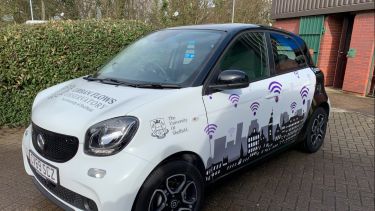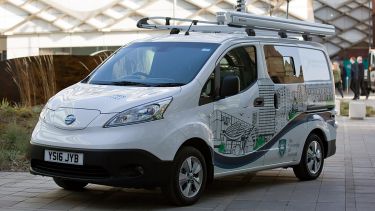Resources, Infrastructure Systems and built Environments Group
The RISE research group aims to enable sustainable built environments that are resilient to a changing climate and allow humanity to live in health and prosperity within the carrying capacity of the planet.

Our research is organised across three core thematic areas:
Research topics
- Resources
-
Our group has expertise in how material and energy use within the built environment can be effectively measured, understood and minimised. This includes the developing methodologies for characterisation of existing stocks, prediction of future material stocks in the built environment, assessment of their circular economy potential, and consideration of the trade-offs between wider environmental impacts, including greenhouse gas emissions. Our work within the Resources theme takes a multi-scale, system-level approach, considering individual materials, components and systems across buildings, cities, regions and the globe.
- Infrastructure Systems
-
We study urban systems and the extent to which their performance and evolution is influenced by their embedded physical infrastructure and how resilient they are to shocks. Our work includes complexity in cities, urban scaling and allometry, city morphology and infrastructure planning. We are particularly interested in the impacts of extreme climate change conditions by the end of the century on performance and resilience of urban systems.
- Built Environment
-
We specialise in how energy efficient buildings can be designed, operated and maintained such that they provide a comfortable and healthy environment for their occupants. We are particularly interested in the relationship between building physics and indoor air quality, using a range of methods from numerical simulations to experimental studies and field work.
Current Projects:
| Title | Funding body | PI |
|---|---|---|
| BuildZero | EPSRC | Danielle O Densley Tingley |
| Breathing City | NERC | Abigail EA Hathway |
| TAPAS (Tackling Air Pollution At School) | NERC | Carolanne Vouriot |
| Embedding Circular Economy Considerations within Built Environment Governance | HEIF | Charles Gillott |
| Behavior of the interfaces between steel and timber members at elevated temperatures | Innovation Fund Denmark | Martyn McLaggan; Ian Burgess; Buick Davison; Shan-Shan Huang |
| The changing profile of climate related transport infrastructure failure in the north | IAA/QR | Hadi Arbabi |
Recent Projects:
| Title | Funding body | PI | |
|---|---|---|---|
| CORONA | EPSRC | Martin Mayfield, Danielle Densley Tingley | |
| DecarboN8 | EPSRC | Danielle Densley Tingley | |
| Multi-scale, circular economic potential of non-residential building stock | EPSRC | Danielle Densley Tingley | |
| Urban Flows Observatory | EPSRC | Martin Mayfield, Danielle Densley Tingley | |
| Technical and Behavioural challenges to improving ventilation is small scale hospitality | PROTECT national core study in Covid prevention, Sheffield City Council and HEIF | Abigail EA Hathway | |
| AIRBODS | UKRI | Abigail EA Hathway | |
| Policy and practice: understanding the built environment's transition to a circular economy in the UK and Canada | UKRI/Mitacs | Danielle Densley Tingley Charles Gillott | |
| Regenerate | HEIF | Danielle O Densley Tingley Charles Gillott | |
| Active Building Centre Research Programme | EPSRC | Martin Mayfield; Danielle Densley Tingley |
Urban Flows Observatory Fleet
Below are images and description of the vehicles we use in the Urban Flows Observatory project.
- Morca
-
Morca provides a broad understanding of just how crowded the radio frequency (RF) spectrum is in our cities. Morca’s drive-tests provide information as to the direction of a radio source and map the use of radio technology supporting mobile phones, Wi-Fi and new Internet of Things (IoT) devices. The structure of our urban landscapes is changing rapidly and we need to know more about how large-scale construction affects the effectiveness of wireless networks, to provide a reliable communications infrastructure.
- MARVel
-
The Multi-spectral Advanced Research Vehicle (MARVel) has multi-sensor capture, comprising visual cameras for radial capture of visible-spectrum band images; infrared cameras to measure thermal radiation; hyperspectral line scanners for wide-band spectral imaging; and full LiDAR coverage to build high-resolution 3-D point clouds. Additionally, the vehicle features a combined global navigation satellite system and inertial measurement unit, which can record positional information to allow data to be globally synchronised.
- Mobius
-
Mobius features air quality analysers, a weather station and antenna air monitors. This enables it to collect accurate measurements of air quality, including NOx, Particulates and Ozone, collect information on influencing factors such as temperature, humidity, wind speed and wind direction, and provide air quality metrics at a height of up to nine metres via a telescopic mast.
People Involved
Our dedicated staff that make this research possible.
Academics
| Name | Research Themes |
|---|---|
| Arbabi, Dr Hadi | Lecturer in the Built Environment |
| Densley Tingley, Dr Danielle | Senior Lecturer in Architectural Engineering |
| Hathway, Dr Abigail | Senior Lecturer in Architectural Technology |
| Mayfield-Tulip, Prof. Martin |
Head of Department Professor of Engineering Design |
| McLaggan, Dr Martyn | Lecturer in Low Carbon Design |
| Vouriot, Dr Carolanne | Lecturer in Building Physics |
Affiliate members
| Name | Research Themes |
|---|---|
| Davison, Prof. Buick |
Deputy Head of Department Professor of Structural Engineering |
| Stovin, Prof. Virginia | Professor of Green Infrastructure for Stormwater Management |




